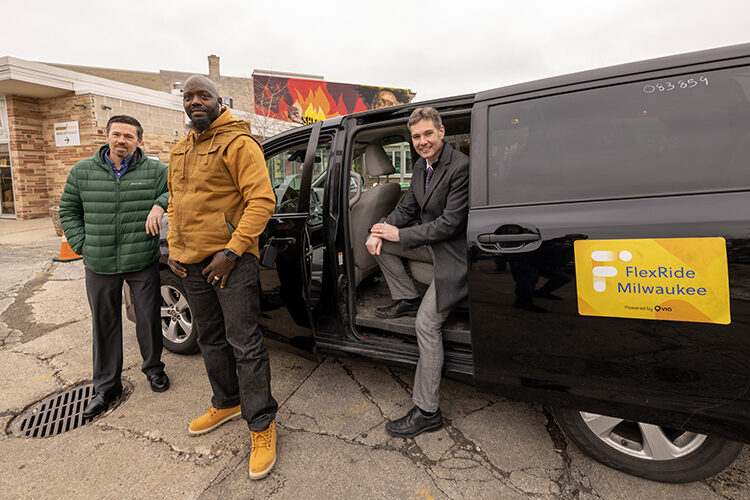Suburban employers have job vacancies they can’t fill. There are plenty of job seekers in Milwaukee County, but many don’t own a vehicle and the Milwaukee County Transit System can provide service only to the county line.
To try to solve this mismatch, UWM urban planners partnered with the Southeastern Wisconsin Regional Planning Commission (SEWRPC) and other agencies last year to build and test a microtransit system called FlexRide. That’s an on-demand option that is more flexible than the fixed bus routes. Think of Uber or UberX Share.
Now, after a year of operating the FlexRide pilot program, the number of returning riders continues to grow steadily. The number of riders in November topped 2,300. Currently, ridership hovers around 200 per day.
UWM Professor Robert Schneider and his students are analyzing the data from surveys collected March 1 to Nov. 30, 2022, to see whether FlexRide allowed city residents to be employed in the suburbs where more jobs are available. Though they haven’t completed the assessment yet, Schneider said, they have promising indicators.
“What we can say is, we see that the most frequent riders of the service had slightly higher incomes than some of the people who didn’t ride as often,” he said. “And our guess, without knowing more, is that those riders were able to either keep a job or get a job, leading to a more stable income than people who didn’t continue to use the service.”
The idea for FlexRide took off after Ivy Hu, former UWM professor of urban planning, applied for funding through the National Science Foundation in 2021. The NSF provided $50,000 for planning and $1 million for operating the service for a year.
“With local transit systems facing significant funding challenges, there was no feasible way to test out a new on-demand transportation program without those NSF funds and the great partnership formed around this pilot,” said Eric Lynde, chief special projects planner at SEWRPC.
In Milwaukee, FlexRide connects city neighborhoods on the near north side with employment hubs in Butler and Menomonee Falls. Riders are picked up in two Milwaukee zones. Zone 1 is closest to the Waukesha employers and the fare from that zone is free. Zone 2 is farther from the employment destinations, and riders pay $1.50 each way for the service.
Testing the fare
FlexRide is intended to be what is often called a “last mile solution,” in which riders take the Milwaukee County Transit System to the end of its route and then take FlexRide the rest of the way. But the researchers found that two-thirds of riders made the request from the paid zone.
Once a rider requests a ride, either through the app or by a phone call, a vehicle picks them up within 10-15 minutes in a location close to their location, such as the nearest intersection. The service has been operating weekdays from 4:30 a.m. to 11:30 p.m.
Schneider said the pilot project has confirmed that a need exists and that riders are willing to pay a fare.
“The challenge with this, is that it’s expensive to provide,” he said. “And so, as FlexRide moves toward the future, officials have to try to figure out how to make it sustainable.”
Lynde said he hopes insight from Schneider’s analysis will reveal what a sustainable design of the service could look like. The fare structure for the pilot, which is still in effect, was never intended to be permanent, he said. The purpose was to test rider preferences.
Now the partners are trying to determine how raising the fare could affect the number of riders using the service.
In surveys, Schneider and his team asked those who applied to use the service if they were willing to pay for it – and how much. Answers ranged from $2 or $3 on up to $10.
“By comparison, for a lot of people, a ballpark estimate of taking a Lyft or an Uber for this type of trip would be $20 to $25. So it’s reasonable that some people would be willing to pay $10,” he said.
Making the service sustainable
The next iteration of the service model may also make other changes, Lynde said.
For example, as 2022 wore on and ridership increased, the service shifted to taking more than one rider at a time with several pickup points along the way, adding to the efficiency, he said. Businesses may be willing to help support the service financially by covering part or all of an employee’s fare, he said.
Schneider’s team also have gleaned a better picture of who is using the services regularly.
Riders and applicants to the services were majority African American and had no access to a vehicle. Other demographics include:
- Over 60% were younger than 35.
- 55% were unemployed.
- 59% were very low income, meaning they made less than $1,500 a month, but the most frequent riders had a wider range of income levels.
“Understanding what riders prefer and why they prefer it is important as the service undergoes key changes over the next few months,” Lynde said. “UWM has provided loads of information that has been used to improve the service and plan for the future.”
The next stage of FlexRide will launch April 1 and continue through 2024 thanks to a $4.2 million grant from the Wisconsin Economic Development Corporation. The new funding was secured by MobiliSE, a nonprofit organization that unites regional leaders around transportation issues and seeks solutions.
With this new funding, MobiliSE plans to expand the service into Franklin and New Berlin, and coordinate with child-care centers in FlexRide’s service zones to make them safe and convenient pickup spots for FlexRide passengers.
“Our region is fortunate that NSF provided the funding to try something new for our region, and that UWM and SEWRPC stepped up to launch a groundbreaking pilot,” said Dave Steele, MobiliSE executive director. “As we look to the future of FlexRide Milwaukee, we know the demand for this type of service is there. We’re serving a critical need in our community.”







